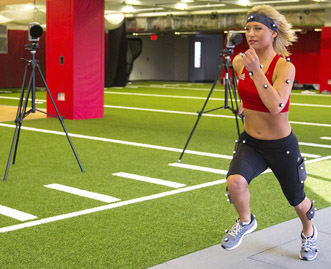
Athletic Performance Research
Date of this Version
2016
Document Type
Article
Citation
Published in Sports Biomechanics 15:4 (2016), pp 440–449. doi:10.1080/14763141.2016.1174286
Abstract
The potential to use the vertical jump (VJ) to assess both athletic performance and risk of anterior cruciate ligament (ACL) injury could have widespread clinical implications since VJ is broadly used in high school, university, and professional sport settings. Although drop jump (DJ) and VJ observationally exhibit similar lower extremity mechanics, the extent to which VJ can also be used as screening tool for ACL injury risk has not been assessed. This study evaluated whether individuals exhibit similar knee joint frontal plane kinematic and kinetic patterns when performing VJs compared with DJs. Twenty-eight female collegiate athletes performed DJs and VJs. Paired t-tests indicated that peak knee valgus angles did not differ significantly between tasks (p = 0.419); however, peak knee internal adductor moments were significantly larger during the DJ vs. VJ (p < 0.001). Pearson correlations between the DJ and VJ revealed strong correlations for knee valgus angles (r = 0.93, p < 0.001) and for internal knee adductor moments (r = 0.82, p < 0.001). Our results provide grounds for investigating whether frontal plane knee mechanics during VJ can predict ACL injuries and thus can be used as an effective tool for the assessment of risk of ACL injury in female athletes.
Included in
Bioinformatics Commons, Biomechanics Commons, Biophysics Commons, Exercise Science Commons, Motor Control Commons, Psychology of Movement Commons


Comments
Copyright © 2016 Informa UK Limited/Taylor & Francis Group. Used by permission